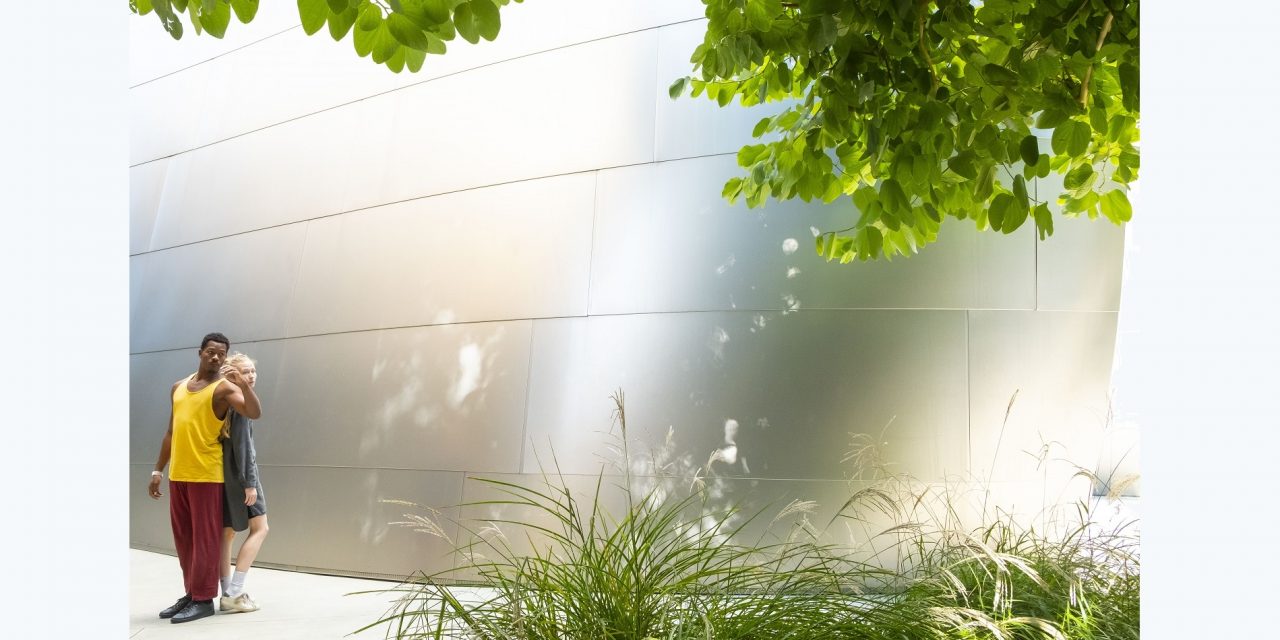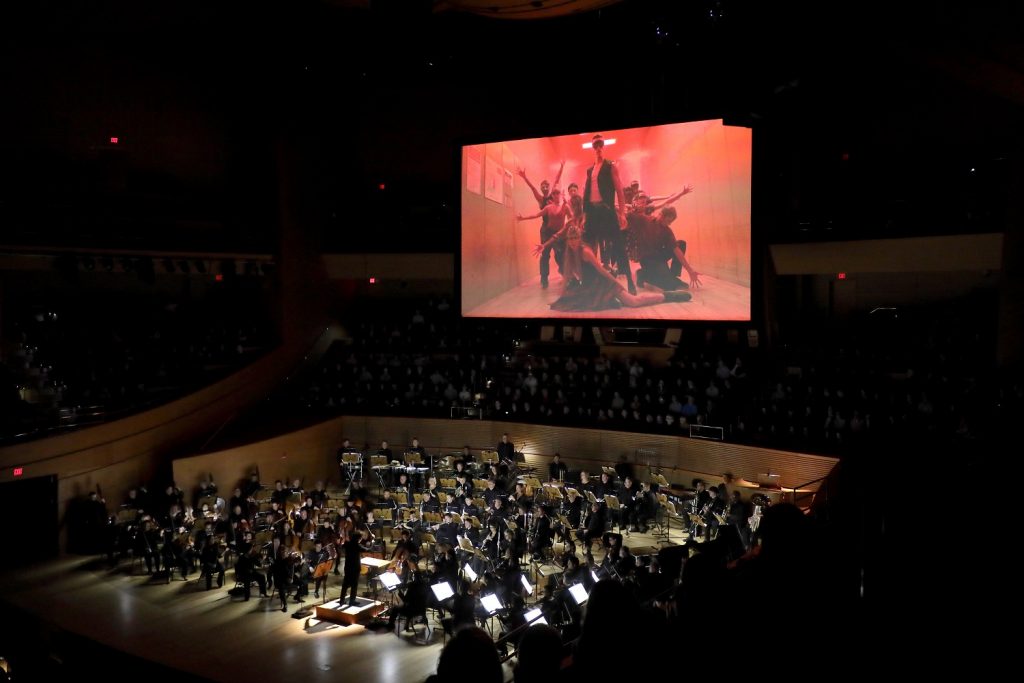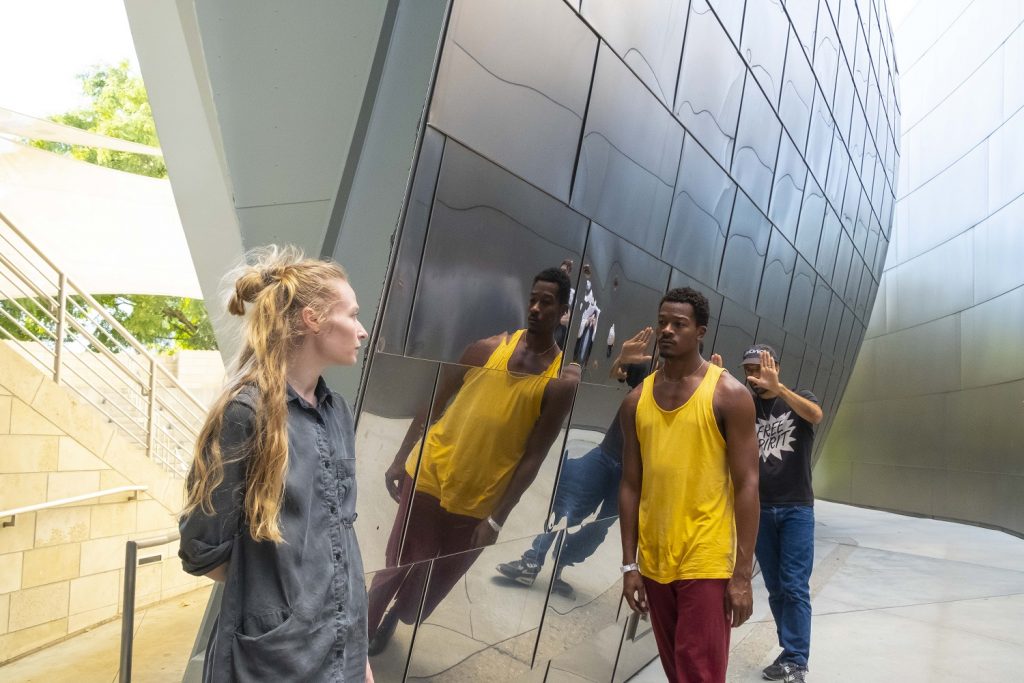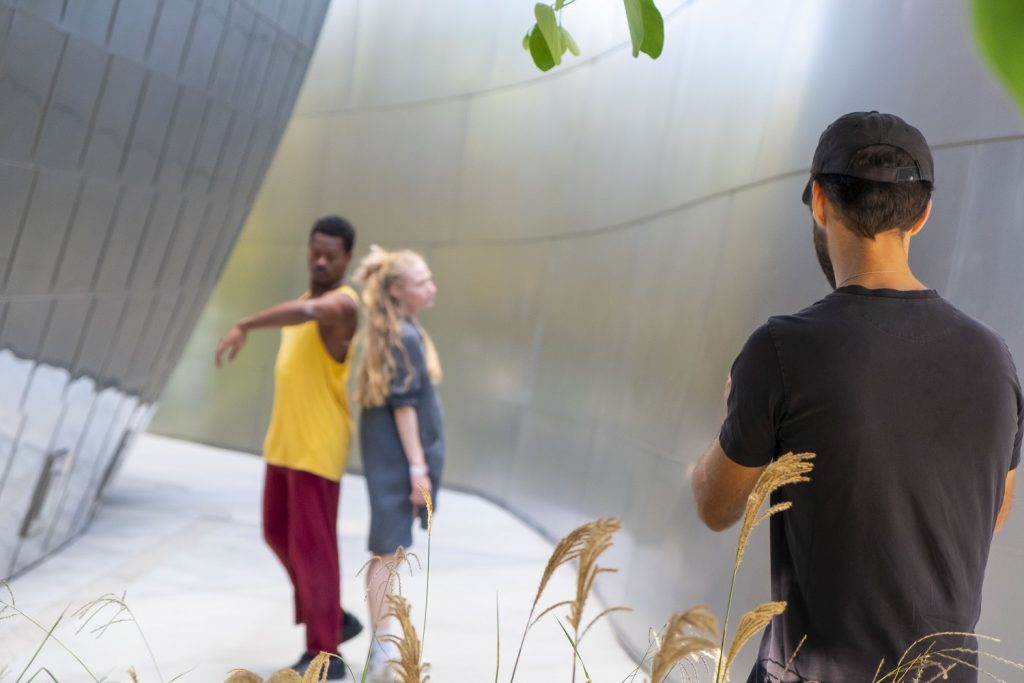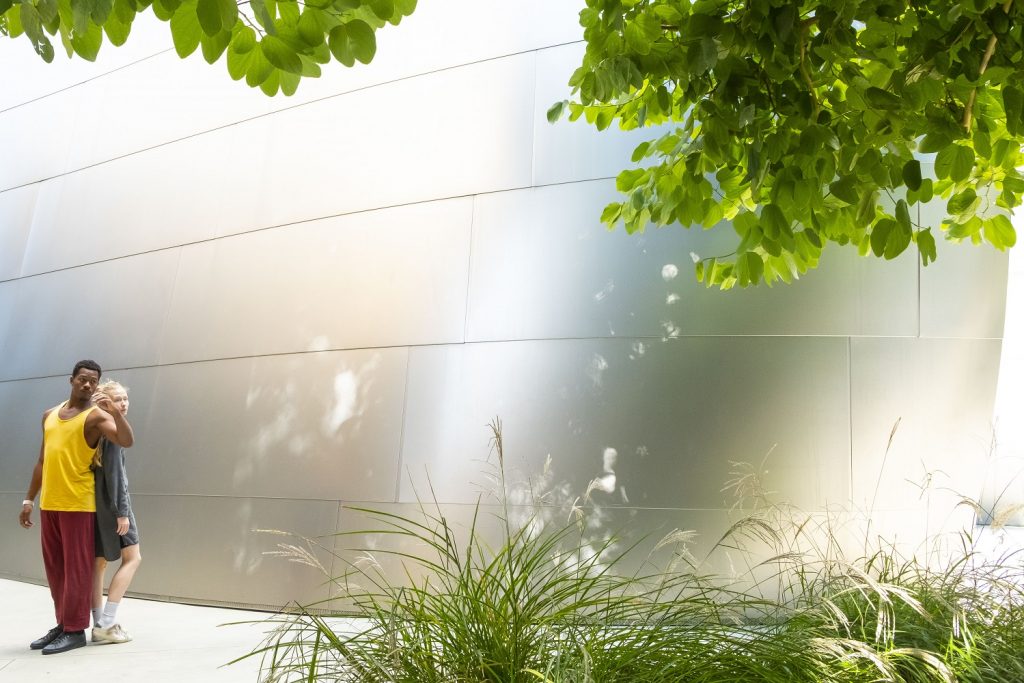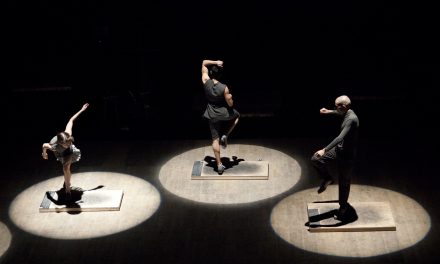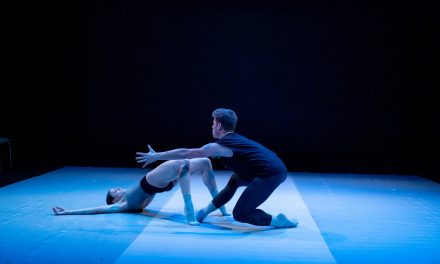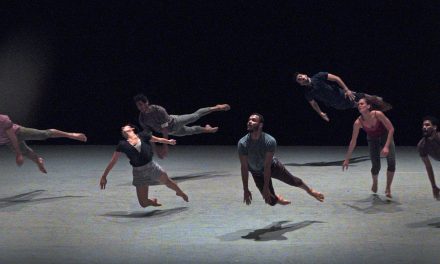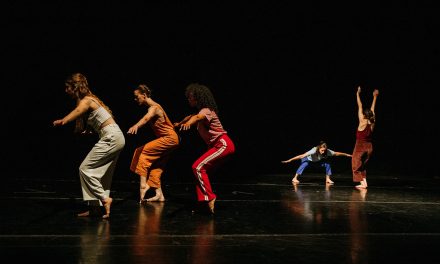On Thursday night, October 18, audiences entered the Walt Disney Concert Hall with bated breath in anticipation of the premiere of Romeo & Juliet. A secretive show planned between the LA Philharmonic and the L.A. Dance Project, the only details revealed in features about the production were that it would include a full musical rendition of the nearly three-hour ballet, titled Op. 64, written by Russian composer Sergei Prokofiev in 1935. L.A. Dance Project kept their role entirely under wraps, only hinting in previews that they would be performing the balcony scene. What followed, however, were explosive segments of the most climactic moments within Shakespeare’s story. They were set in different locations throughout the inside and outside of the building, creating a unique experience capable of making the tragedy’s most weary fans the opportunity to rediscover its beauty.
Inside the theater, the orchestra was pushed back just enough to allow a couple of rows of dancers to join the musicians on stage. Conductor and artistic director Gustavo Dudamel appeared to loud applause. Moments later, the band had begun to play, igniting the ballet with the first, sweet notes of the “Introduction”. The string-heavy piece set a romantic tone eagerly taken over by clarinets before a tentative bassoon added a touch of innocence to the scene, painting a picture of the teenage love to come.
Shortly after Act I had begun, the doors opened widely on either side to let in the dance company, which appeared dressed in modern clothing and sneakers. The shoes impeded some of the balletic foot pointing, but the overall effect was a young-looking ensemble, with their outward appearance matching artistic director Benjamin Millepied’s quirky choreography. They six-person troupe coupled off, bending their knees alternatively to the blare of the brass section, making sharp half turns to each shifting note. Their high energy was like that of a college frat party, entering like a whirlwind before disappearing off stage as suddenly as they had shown up.
The orchestra’s playing was consistent throughout the entire evening, their vivacity painting each violent fight, timid encounters and royal order in the viewers’ mind. Their phenomenal playing ensured that the music was center stage the entire length of the ballet, driving the plot forward with few pauses in between each scene. Prokofiev’s 80-year-old composition is as surprisingly grandiose as a modern movie soundtrack with a gothic romantic edge, especially as directed by Dudamel. His conducting transformed him into an additional dancer, curls bouncing wildly as he rose onto his tiptoes with every elevated tempo and subdued his arm movements, softening them into waltzing gestures during the ballet’s more tender moments.
The only strange part of LA Phil’s staging was that of an additional horn section, which was buried behind the stage’s side doors. During a few scenes in Act I, there were moments of confusion among audience members who had noticed that no one on stage was playing, while Dudamel continued to conduct furiously. After a bit of shifting and neck craning it became clear that the doors, which had suddenly opened before the ghost sound was heard, were meant to let in sound and not the returning ensemble.
However, the company’s next appearance was during “Dance of the Knights” (Scene 2.12), also known as “The Montagues and the Capulets” from Prokofiev’s extracted Suite No. 2., the ballet’s most well-known piece. During this segment, a few of the men from L.A. Dance Project briefly returned, crossing the threshold quickly before almost-immediately scurrying down one of the concert hall’s passages. As they left, the orchestra’s platform darkened, and an overhead projector began live streaming their movements. Millepied was trailing behind the trio with a camera. He followed them down to a red-lit corridor where they met up with the rest of the ensemble and together enacted a daring version of the famous masquerade scene.
The atmosphere ignited by their awareness of the camera, which they sometimes grabbed and stared into, was borderline comic. It hinted at the characters’ sense of entitlement, born from their privileged opportunity to be invited to the royal court. Though appropriately tied into their state of mind, the lasting effect was a bit too Hollywood, with their obnoxious teenage perspectives recalling the corniness often associated with the Romeo and Juliet’s storyline a little too intensely. Especially as the dancers strutted like West Side Story gang members (a direct allusion to Jerome Robbins’ work from the 1957 Broadway musical). Part of what was expressed in the dancing was “Juliet’s Variation”, a waltz of sorts indicating the yellow Hawaiian shirt–wearing Romeo (David Adrian Freeland, Jr.), whose outfit was reminiscent of Leonardo Dicaprio in the 1996 film Romeo + Juliet, and Juliet (Janie Taylor)’s first meeting. The music here was lightly tinged with tragedy, as the protagonists’ impending fate loomed over the production. Nowhere was it more prevalent than in the wonderfully executed balcony scene.
Not long after the masked ball ended, and the music played through a few more transitional scenes in the ballet, a blue light illuminated the staircase rising alongside the stage to indicate L.A. Dance Project’s return to the stage. Juliet appeared at the top of the stairs with Romeo courting her from the bottom rung before slowly making his way up so that they could share their first intimate moments together. As they ran down the hall, Millepied could be seen trailing to live stream their movements, his brief appearance giving the ballet a documentary-like feel. The couple quickly made their way out to the roof where they engaged in a charming pas de deux. Their dancing here was most similar to that of traditional ballet. Millepied’s choreography shined through in charming moments during which their intermingling arms forming “x”-es between their bodies as a way to symbolize their distance as star-crossed lovers.
Freeland’s handling of Taylor’s waif-like body was indicative of their characters’ love. He maneuvered her swiftly and carefully, lifting her only slightly from the ground so that her arms and legs would spread and float through the air as the camera chased behind them. Much of their gallivanting took place through the rooftop gardens, against the Los Angeles cityscape and along the building’s mirrored outer walls. Millepied’s camerawork added a phenomenal layer to their ethereal movement. He spun in circles around them, brought the camera down slowly upon them when they laid their bodies softly upon the grass, and at the scene’s conclusion, focused on their kissing silhouettes and Taylor’s blushing face as Freeland made his way down the steps, the enamored look still plastered on his face before he exited.
The remaining dance numbers focused on Romeo’s tumultuous murdering of the cocky Tybalt (Nathan B. Makolandra) within the theater’s offices, and a few on-stage ditties that added visual interest to the music. The final scene, however, was by far the most poignant, after the ephemeral beauty showcased in the balcony scene.
A dark procession led the ensemble down a corridor below the stage into what appeared to be the catacombs, symbolized by the room’s cave like feel and wooden framework. Taylor lay on a box in the middle of the “room”. Once the others had gone, Freeland picked her body up and began to slow dance with her, his overwhelming grief engulfing the audience through the screen. Taylor’s ability to make her body seem rag doll–like and lifeless, while still moving alongside Freeland’s desperate form, increased the scene’s sadness, especially as she briefly came to life, vividly dancing alongside him before collapsing into his arms as his fantasy ended and the musical notes sunk down into low base tones once again. Their misery was so far elevated that its power almost dulled her later on-stage revival and discovery of his dead body hugging hers. By the time both had individually decided to poison themselves by way of overdosing on pills, the power of the dancing had already stupefied the audience into a hopeless acceptance of their impending doom.
This one-of-a-kind interpretation of Shakespeare’s classic allowed me to feel the most empathy I have ever felt for the characters of Romeo and Juliet. It was a complete rediscovery of a familiar tale, which transformed it from overdone, to timeless once again. I only wish they would have incorporated more dancing into the mix, only because of how well–coordinated and performed each segment was. However, that desire is not meant to take any credit away from Dudamel’s powerful conduction, the orchestra’s seamless flow and the successful partnership between the centennial LA Phil and six-year-old L.A. Dance Project, two cutting-edge companies doing an incredible job of elevating LA’s arts scene through this spectacularly memorable show and weekend.
For more information about L.A. Dance Project, click here.
For more information about L.A. Philharmonic, click here.
Featured image: L.A. Dance Project in rehearsal for Romeo and Juliet at Walt Disney Concert Hall – Photo: Jonathan Potter

